Proposed Expansion for Chickasaw and Lower Hatchie National Wildlife Refuges
OutdoorHub 12.04.12

As part of its continuing effort to conserve, protect, and enhance fish, wildlife, plants, and their habitats for the continuing benefit of the American people, the U.S. Fish and Wildlife Service, Southeast Region, is proposing to expand the acquisition boundaries of Chickasaw and Lower Hatchie National Wildlife Refuges. This expansion, if approved, would allow the purchase of lands, only from willing sellers, within an expanded area stretching from Hatchie NWR on the east to Lower Hatchie NWR on the southwest, and north to Chickasaw NWR. The majority of lands within the proposed expansion consist of seasonally flooded bottomlands, as well as important habitats along 49 miles of the Mississippi River and 106 miles of the Hatchie River. If approved, the expanded acquisition boundary would add a total of 120,078 acres to the acquisition boundaries of all three refuges.
The goals of this proposal are to protect and enhance the natural function of the un-leveed bottomlands along the Hatchie and Mississippi Rivers in western Tennessee, to provide high quality wildlife habitat, clean water, and public wildlife-dependent recreation opportunities, to improve aquatic habitats important for game fish as well as aquatic species of conservation concern, to protect and restore unfragmented bottomland hardwood forest as part of a region-wide effort to rebuild the bottomlands of the Lower Mississippi Valley, and to enhance and restore biological diversity, watershed health, and ecosystem function at a landscape scale.
If the proposal is approved, the Service would be working with partners, including the Tennessee Wildlife Resources Agency, Tennessee Department of Environment and Conservation, Tennessee Department of Agriculture, multiple conservation organizations (NGOs), and private landowners to protect and enhance fish and wildlife habitats which would ultimately connect Chickasaw National Wildlife Refuge with John Tully Wildlife Management Area (WMA), Cold Creek WMA, Fort Pillow State Park, John Tully State Forest, and Lower Hatchie and Hatchie National Wildlife Refuges.
The Service has been working with partners for nearly 50 years to protect and enhance wildlife habitat in bottomlands along the Mississippi and Hatchie Rivers in western Tennessee. These lands, which make up the Chickasaw, Hatchie, and Lower Hatchie National Wildlife Refuges, provide high quality habitat for waterfowl, deer, turkey, and many nongame species, as well as places where the public can go to hunt, fish, and observe wildlife. Expanding this acquisition boundary would enhance the Service’s ability to provide habitat for migratory birds, fisheries, resident game and nongame animals, and rare, threatened, and endangered species by helping protect habitat corridors along major wildlife travel routes. The re-establishment of wildlife corridors will restore natural patterns of wildlife movement and increase the size and health of wildlife populations, especially those of wide-ranging and migratory species.
Bottomland hardwood forests of the Mississippi Alluvial Valley serve as important habitat for breeding landbirds and migratory birds in the spring and fall, and the Lower Mississippi Valley serves as the primary wintering ground for mid-continental waterfowl populations.
Together, Chickasaw, Lower Hatchie, and Hatchie NWRs support more than 300,000 dabbling ducks each winter. Acquisition of lands in the proposed acquisition boundary could provide up to 56,000 acres of restored bottomland and upland forest, protect an additional 27,000 acres of existing forest within the proposed expansion boundary, and, when combined with existing Federal and State lands, provide approximately 190,000 acres of contiguous forest habitat to support objectives outlined in other National and State plans for waterfowl, priority landbirds, waterbirds, upland wildlife, reptiles, amphibians, and fish.
Three federally listed wildlife species occur in the region: the interior least tern, the pallid sturgeon, and the wood stork. In addition, other rare or imperiled species present or potentially present in the proposed acquisition boundary include Mississippi kite, Rafinesque’s big-eared bat,Indiana bat, fish including the blue sucker, firebelly darter, sturgeon chub, and sicklefin chub, southern hickorynut (mussel), Hatchie burrowing crayfish, and several plants of conservation concern.
Completion of the final plan, and submission for approval to the Director of the U.S. Fish and Wildlife Service, is anticipated to take place in summer, 2013. Acquisition could begin after approval, but the rate at which lands were purchased would depend on funding and availability of suitable lands for sale. Land purchases would be funded through the Migratory Bird Conservation Fund and the Land and Water Conservation Fund, which are funded by user fees, federal duck stamps, revenue from leasing offshore oil drilling rights, and other, non-tax sources.
Opportunities for the public to comment on the proposed expansion include two public scoping meetings; the first to be held at 6:00 pm on December 11, 2012, at the Tennessee Technology Center in Ripley, Tennessee, with the second meeting taking place at 6:00 pm on December 12, 2012, at the Brownsville Chamber of Commerce in Brownsville, Tennessee. After this initial public review and comment period, a yet-to-be determined number of public meetings will be held in March, 2013, for additional public review and comments on the Draft Land Protection Plan and Environmental Assessment.
More information is at: http://www.fws.gov/westtnrefuges/

